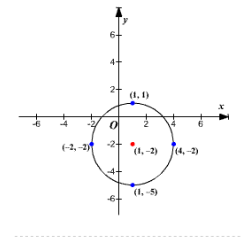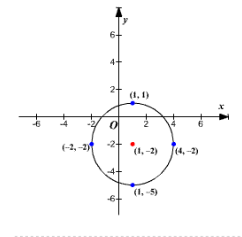
To find: the center and radius of each circle and graph the circle.
Answer to Problem 23RE
The center of the circle (h, k) is (1, -2) and the radius r is 3.

Explanation of Solution
Given:
x2+y2−2x+4y−4=0
Calculation:
Group the terms containing x and the terms containing y . Bring the constant to theright side of the equation.
(x2−2x)+(y2+4y)=4
Express the terms within the parentheses as perfect squares. Any number added on the left-hand side must be added on the right-hand side also.
(x2−2x+1)+(y2+4y+4)=4+1+4 ↑︷(22)2=1 ↑︷(42)2=4
Factor the expression.
(x−1)2+(y+2)2=32
The standard equation of a circle with center (h, k) and radius r is (x−h)2+(y−k)2=r2 .
Express the equation in standard form
(x−1)2+(y+2)2=32
Compare the equation with the standard form.
(x−h)2+(y− k)2= r2 ↓ ↓ ↓(x−1)2+(y−(−2))2=32
Therefore, the center of the circle (h, k) is (1, -2) and the radius r is 3.
The center of the circle is at the point (1, -2). Since the radius is 3 units, four points on the circle can be located by plotting points that are 3 units to the right, to the left, up, and down from the center. Use these points to graph the circle.

Substitute y=0 in the standard equation to find the x -intercept.
(x−1)2+(0+2)2= 9(x−1)2+ 4 = 9
Subtract 4 from both the sides.
(x−1)2+4−4=9−4 (x−1)2=5
Use the square root method.
x−1=±√5
Add 1 to both the sides.
x−1+1=±√5+1x=1±√5
The x -intercepts are 1+√5 and 1−√5 .
Substitute x=0 in the standard equation to find the y-intercept
(0−1)2+(y+2)2=91+(y+2)2=9
Subtract 1 from both the sides.
1+(y+2)2−1=9−1(y+2)2=8
Use the square root method.
y+2=±√8
Subtract 2 from both the sides.
y+2−2 = ±√8−2y=−2±√8
The y intercepts are −2+√8 and −2−√8 .
Conclusion:
Therefore, the center of the circle (h, k) is (1, -2) and the radius r is 3.
Chapter 1 Solutions
Precalculus
Additional Math Textbook Solutions
A Problem Solving Approach To Mathematics For Elementary School Teachers (13th Edition)
Basic Business Statistics, Student Value Edition
Algebra and Trigonometry (6th Edition)
Calculus: Early Transcendentals (2nd Edition)
Precalculus
Pre-Algebra Student Edition
- 8:39 *** TEMU 5G 60% A ferris wheel is 28 meters in diameter and boarded from a platform that is 2 meters above the ground. The six o'clock position on the ferris wheel is level with the loading platform. The wheel completes 1 full revolution in 4 minutes. The function h = f(t) gives your height in meters above the ground t minutes after the wheel begins to turn. What is the amplitude? 14 meters What is the equation of the Midline? y = 16 What is the period? 4 meters minutes The equation that models the height of the ferris wheel after t minutes is: f(t): = ƒ (3) = ·−14(0) + 16 syntax error: you gave an equation, not an expression. syntax error. Check your variables - you might be using an incorrect one. How high are you off of the ground after 3 minutes? Round your answe the nearest meter. ||| <arrow_forwardcan you solve this question step by step pleasearrow_forwardS cosx dx sin -3/ (x) Xarrow_forward
- The evolution of a population of Hippos, R(t), in hundreds, time in years, in an African National Park is given by the equation, dR dt (a) Solve the system exactly for R(t). = R(7 – R); R(0) = 3 2 (b) What happens as the time t → ∞o, i.e. what is the population a long time in the future? (c) Write an Euler scheme and compute until the population levels off (using Excel, Matlab, Octave, LibreCalc or similar). Do it twice, once with At = 0.1 and once with At = 0.05. (d) Plot all of your solutions on the same set of axes and comment.arrow_forwardfind For triangle ABC, with vertices A = (3,-1,2), B = (-5,4,-4) and C = (6, −1, −1), (a) the length of side AB, (b) the equation of the line that passes through A and B, (c) the angle at vertex B, (d) a vector perpendicular to the plane containing the triangle ABC, (e) the area of the triangle ABC. (f) the equation of a plane passing through A, B and C.arrow_forwardShowing all working, use the row reduction method to find the inverse of B, given by 5 -1 B = -3 1 3 1 -3 2arrow_forward
- Consider the matrix A, given by +63) A = 1 -3 4 -3 4 5 -105 (a) Find the determinant of the matrix, A. (b) Find all possible solutions, x, to the system Ax = b, where b is the column vector, (1,2, −4).arrow_forwardIf a (1,4,2) and b = (−1, −5,3), find |a|, a + b, 3a - 2b, a b, a x b and b × a. What is the angle between a and b?arrow_forwardShowing all working, find the eigenvalues and corresponding eigenvectors of -3 (a) (27) 6arrow_forward
 Calculus: Early TranscendentalsCalculusISBN:9781285741550Author:James StewartPublisher:Cengage Learning
Calculus: Early TranscendentalsCalculusISBN:9781285741550Author:James StewartPublisher:Cengage Learning Thomas' Calculus (14th Edition)CalculusISBN:9780134438986Author:Joel R. Hass, Christopher E. Heil, Maurice D. WeirPublisher:PEARSON
Thomas' Calculus (14th Edition)CalculusISBN:9780134438986Author:Joel R. Hass, Christopher E. Heil, Maurice D. WeirPublisher:PEARSON Calculus: Early Transcendentals (3rd Edition)CalculusISBN:9780134763644Author:William L. Briggs, Lyle Cochran, Bernard Gillett, Eric SchulzPublisher:PEARSON
Calculus: Early Transcendentals (3rd Edition)CalculusISBN:9780134763644Author:William L. Briggs, Lyle Cochran, Bernard Gillett, Eric SchulzPublisher:PEARSON Calculus: Early TranscendentalsCalculusISBN:9781319050740Author:Jon Rogawski, Colin Adams, Robert FranzosaPublisher:W. H. Freeman
Calculus: Early TranscendentalsCalculusISBN:9781319050740Author:Jon Rogawski, Colin Adams, Robert FranzosaPublisher:W. H. Freeman
 Calculus: Early Transcendental FunctionsCalculusISBN:9781337552516Author:Ron Larson, Bruce H. EdwardsPublisher:Cengage Learning
Calculus: Early Transcendental FunctionsCalculusISBN:9781337552516Author:Ron Larson, Bruce H. EdwardsPublisher:Cengage Learning





